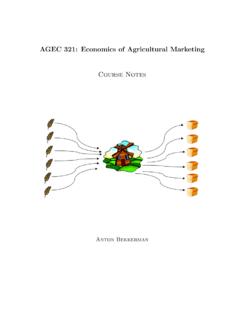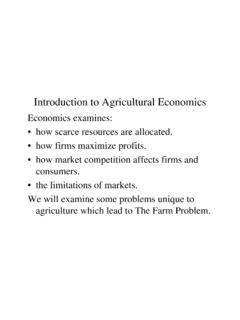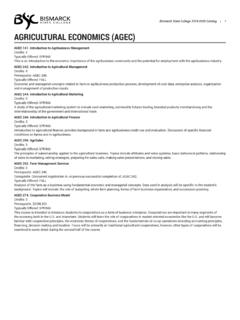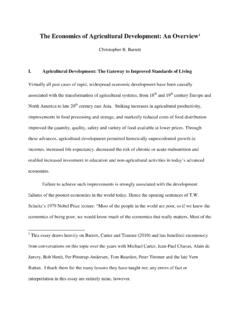Transcription of Introduction to Agricultural Economics - testbanktop.com
1 Online Instructor s Manual to accompany Introduction to Agricultural Economics Fifth Edition John B. Penson, Jr. Oral Capps, Jr. C. Parr Rosson III Richard T. Woodward Prentice Hall Boston Columbus Indianapolis New York San Francisco Upper Saddle River Amsterdam Cape Town Dubai London Madrid Milan Munich Paris Montreal Toronto Delhi Mexico City Sao Paulo Sydney Hong Kong Seoul Singapore Taipei Tokyo _____ Copyright 2010 Pearson Education, Inc., publishing as Prentice Hall, Upper Saddle River, New Jersey and Columbus, Ohio. All rights reserved. Manufactured in the United States of America. This publication is protected by Copyright, and permission should be obtained from the publisher prior to any prohibited reproduction, storage in a retrieval system, or transmission in any form or by any means, electronic, mechanical, photocopying, recording, or likewise.
2 To obtain permission(s) to use material from this work, please submit a written request to Pearson Education, Inc., Permissions Department, One Lake Street, Upper Saddle River, New Jersey. Many of the designations by manufacturers and seller to distinguish their products are claimed as trademarks. Where those designations appear in this book, and the publisher was aware of a trademark claim, the designations have been printed in initial caps or all caps. 10 9 8 7 6 5 4 3 2 1 ISBN-13: 978-0-13-507027-7 ISBN-10: 0-13-507027-9 TABLE OF CONTENTS Overview of 1 Design of 1 PART 1 Introduction Chapter 1 What is Agricultural Economics ? 3 Chapter 2 The US Food and Fiber Industry 5 PART 2 Understanding Consumer Behavior Chapter 3 Theory of Consumer Behavior 8 Chapter 4 Consumer Equilibrium and Market Demand 12 Chapter 5 Measurement and Interpretation of Elasticities 15 PART 3 Business Behavior and Market Equilibrium Chapter 6 Introduction to Production and Resource Use 18 Chapter 7 Economics of Input and Product Substitution 23 Chapter 8 Market Equilibrium and Product Price: Perfect Competition 28 Chapter 9 Market Equilibrium and Product Price.
3 Imperfect Competition 31 PART 4 Government in the Food and Fiber Industry Chapter 10 Natural Resources, the Environment, and Agriculture 35 Chapter 11 Government Intervention in Agriculture 39 PART 5 Macroeconomics of Agriculture Chapter 12 Product Markets and National Output 43 Chapter 13 Macroeconomic Policy Fundamentals 47 Chapter 14 Consequences of Business Fluctuations 52 Chapter 15 Macroeconomic Policy and Agriculture 56 PART 6 International Agriculture Trade Chapter 16 Agriculture and International Trade 59 Chapter 17 Exchange Rates and Agricultural Trade 62 Chapter 18 Why Nations Trade 65 Chapter 19 Agricultural Trade Policy and Preferential Trading Arrangements 67 Test Item File 72 1 Overview of Manual The purpose of our textbook is to introduce students to the micro and macro
4 Dimensions of the food and fiber industry. Representing nearly one-fifth of the economy s output, the food and fiber industry includes: (1) farmers and ranchers, (2) farm input manufacturers and suppliers, (3) food processors and fiber manufacturers, (4) wholesale and retail trade firms facilitating the flow and fiber products to their final consumer, and (5) those firms like farm lenders who provide specific services to farmers and ranchers. This manual focuses on summary material presented in the textbook. Restated here are the learning objectives for each chapter, key terms and their definitions found in each chapter, and the answers to the exercises appearing at the end of each chapter. A test bank, which includes questions and answers that have been used in our classroom, is included at the back of this manual.
5 Finally, a CD containing Microsoft Powerpoint slide shows for each of the chapters is included inside the back cover of the manual. These slide shows can be modified to suit the needs of the instructor. Design of Textbook We begin the book by answering the question raised by the title of Chapter 1, What is Agricultural Economics ? We address this question by first defining the field of Economics and then developing a definition of Agricultural Economics based on the role that Agricultural economists play at both the micro and macro levels. Chapter 2 discusses the changing structure of agriculture during the post-World War II period and the structure of those sectors in the economy that supply farmers and ranchers with inputs and process their output.
6 Part II helps students understand the economic decisions made by consumers of food and fiber products. The topics covered here include the forces influencing consumer behavior (Chapter 3) and the concept of market demand for a particular product (Chapter 4). Part II concludes with the elasticity of demand (Chapter 5). The specification of various elasticity measures is supplemented by empirical examples and their relevance to decision making in the food and fiber industry, including the potential magnitude of consumer response and the implication for producer revenue. Part III turns to the supply side of the market. Issues related to resource use and production response by businesses in the short run are documented in Chapter 6.
7 The economic forces underlying the firm s input use choice of commodities to produce is addressed in Chapter 7. Chapter 8 introduces the market supply curve, followed by the determination of market clearing prices and quantities under perfect competition. Finally, imperfect competition on the selling side and the buying side are covered in Chapter 9. Empirical examples illustrate the magnitude and applicability of the relationships covered in both Chapters 8 and 9. Part IV addresses the role of government in the food and fiber industry. Chapter 10 outlines the general nature of government involvement in farm economic issues, consumer 2issues, resource issues, and international trade issues. Chapter 11 explores the relationship between market equilibrium and farm program policy, introducing the variety of approaches taken to support prices and incomes of farmers over the last 70 years.
8 This chapter includes the selected farm commodity legislation introduced in 2008. Part V focuses on the macroeconomics of agriculture by establishing the relationship between events in the general economy and their impacts on agriculture and other sectors in the food and fiber industry. Chapter 12 begins Part V by outlining the general linkage between product markets and national output. Chapter 13 documents the importance of monetary and fiscal policy to the economic performance of the economy. Chapter 14 illustrates the consequences of business fluctuations in the economy. Chapter 15 concludes this part of the book with a brief walk through the last several decades, illustrating graphically how changes in the macroeconomy affected the economic performance of agriculture.
9 Part VI focuses on international Agricultural trade issues. Chapter 16 examines the growth and instability of Agricultural trade, including the relative dependence on exports and imports. Chapter 17 focuses on the foreign exchange market, the international monetary system, and the effects of foreign exchange rates on Agricultural trade. Chapter 18 explores why nations trade and who gains from trade. Finally, Chapter 19 addresses Agricultural trade policy, the rationale for restricting free trade, the trade policy decision-making mechanisms and institutions, and the formation of preferential trading arrangements and their potential impact. Each chapter concludes with a summary of the chapter s purpose and the major points covered.
10 In addition, the key terms used in the chapters are identified and later defined in a Glossary. Chapters challenge the reader to test their economic quotient with a number of exercises focusing on key issues covered in the chapter. There is also a list of references and further readings on these issues. This textbook differs substantially from the traditional introductory Agricultural Economics textbook in several ways. First, the book explicitly goes beyond the farm gate to address the entirety of the food and fiber industry, which accounts for about 15 percent of national output. Second, the book places an unusually strong emphasis on the macroeconomics of agriculture (four chapters) and international trade (four chapters).















